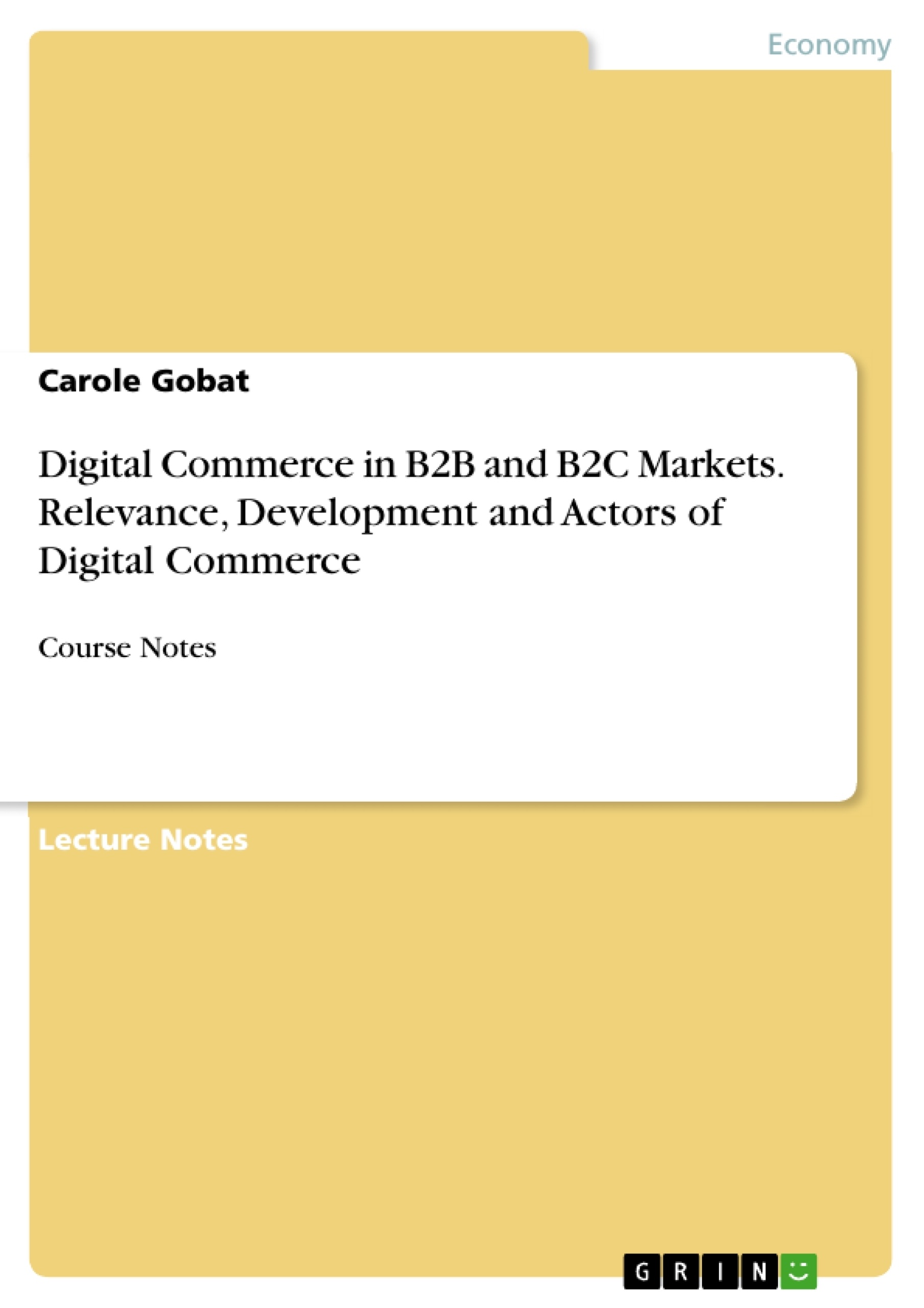The objective of the course is that students understand the most important aspects of digital commerce activities, for example selling of goods and services via the Internet, mobile networks and other emerging channels, to private consumers (B2C) and to commercial customers (B2B). Therefore, in this course, different aspects of Digital Commerce are presented and discussed. This covers the different players that are active in Digital Commerce and the changes in the competitive landscape, disintermediation and new intermediaries, different business models and business strategies in Digital Commerce (for example market places and the perspective of two-sided markets), theoretical foundations from a business strategy, networks and a customer behaviour perspective, marketing instruments of digital commerce companies, cross-channel and omni-channel strategies and relevant decisions along the value chain, for example with regard to delivery options.
Digital Commerce (or E-Commerce) has become highly relevant in many sectors in the last two decades, gaining market shares and leading to the emergence of new players, like Amazon or Zalando, who have become huge companies. Long established companies have added digital sales channels. In addition to the already established online channels, like ordering over a PC or notebook, new channels emerge like mobile channels, scanning solutions or voice assistants as Alexa. In B2B markets, even more forms of digital ordering appear.
Inhaltsverzeichnis (Table of Contents)
- Introduction: Relevance of Digital Commerce
- Typologies and developments in digital commerce
- Digital commerce typology based on the exchange partners
- Digital channels
- SoLoMo (Social Commerce, Local Commerce, Mobile Commerce)
- Individualisation/personalisation
- Actors in the Digital Commerce distribution channel
- Functions of intermediaries in Digital Commerce
- Disintermediation vs. intermediation
- Main types of intermediaries in Digital Commerce (B2B and B2C)
- Disintermediation: "Direct-to-Consumer"
- Further (non-intermediating) actors
- Retail formats and business models in Digital Commerce
- Retail Formats in Digital Commerce
- Retail branding and brand portfolios
- Business models in Digital Commerce
- Market places as two-sided markets
- Two-sided markets
- Network effects
- Power and market structure
- Marketplaces in the "Sharing Economy"
- Amazon and Alibaba
- Marketplaces and platforms in different B2C and B2B sectors
- Multi-, Cross- and Omni-Channel-Commerce
- Strengths and weaknesses of different channels
- Characterisation of the three concepts
- Customer Journey
- 020: Online-retailers opening Stores
- Selected value chain activities of a digital commerce company
- Architecture of the IT systems
- Marketing in Digital Commerce
- Transactions in Digital Commerce
- Logistics in Digital Commerce
- Returns
- Grocery online in selected countries
- Services in Digital Commerce
- CRM in Digital Commerce
- Internationalisation of Online-Shops
- Cross-border shopping: Status and Barriers
- Basic decisions in the internationalisation process
- Internationalisation speed
- Market selection
- Further topics
Zielsetzung und Themenschwerpunkte (Objectives and Key Themes)
This course aims to provide students with a comprehensive understanding of digital commerce activities, encompassing the sale of goods and services via the internet, mobile networks, and emerging channels, both to private consumers (B2C) and to commercial customers (B2B).
- Typologies and developments in digital commerce
- Actors in the Digital Commerce distribution channel
- Retail formats and business models in Digital Commerce
- Market places as two-sided markets
- Multi-, Cross- and Omni-Channel-Commerce
Zusammenfassung der Kapitel (Chapter Summaries)
The introductory chapter explores the relevance of digital commerce, presenting statistics and trends from the USA, Germany, and Switzerland, highlighting the increasing importance of online channels in retail sales across different product categories. The second chapter delves into various typologies and developments in digital commerce, examining the evolution of digital channels, the emergence of SoLoMo (Social Commerce, Local Commerce, Mobile Commerce), and the increasing focus on individualization and personalization in the digital landscape.
Chapter 3 examines the actors within the digital commerce distribution channel, analyzing the functions of intermediaries, the phenomenon of disintermediation versus intermediation, and the different types of intermediaries in both B2B and B2C contexts. This chapter also explores the concept of "direct-to-consumer" disintermediation and the roles of other non-intermediary actors in the ecosystem.
Chapter 4 delves into retail formats and business models within digital commerce, exploring various retail formats used in the online environment, the importance of retail branding and brand portfolios, and a range of business models prevalent in digital commerce.
Chapter 5 examines market places as two-sided markets, discussing the nature of two-sided markets, network effects, power dynamics within such markets, the role of marketplaces in the "Sharing Economy", and providing case studies of Amazon and Alibaba. The chapter concludes by exploring marketplaces and platforms in different B2C and B2B sectors.
Schlüsselwörter (Keywords)
Digital commerce, e-commerce, B2C, B2B, online channels, mobile networks, retail sales, intermediaries, disintermediation, business models, marketplaces, two-sided markets, network effects, multi-channel, cross-channel, omni-channel, customer journey, value chain activities, internationalisation, cross-border shopping, digitalisation.
- Quote paper
- Carole Gobat (Author), 2019, Digital Commerce in B2B and B2C Markets. Relevance, Development and Actors of Digital Commerce, Munich, GRIN Verlag, https://www.grin.com/document/503786




